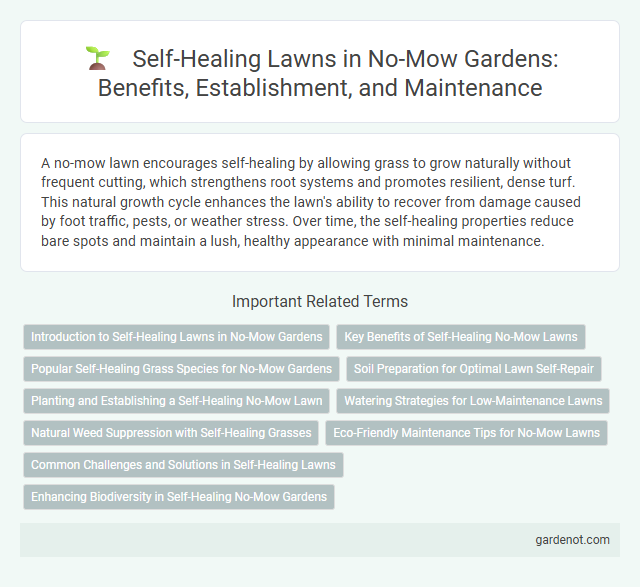A no-mow lawn encourages self-healing by allowing grass to grow naturally without frequent cutting, which strengthens root systems and promotes resilient, dense turf. This natural growth cycle enhances the lawn's ability to recover from damage caused by foot traffic, pests, or weather stress. Over time, the self-healing properties reduce bare spots and maintain a lush, healthy appearance with minimal maintenance.
Introduction to Self-Healing Lawns in No-Mow Gardens
Self-healing lawns in no-mow gardens feature resilient grass species and groundcovers that naturally regenerate after damage or wear, reducing the need for frequent maintenance. These lawns rely on biological processes such as stolon and rhizome growth that quickly fill bare patches without reseeding. Integrating self-healing grass varieties like fine fescues and clover enhances lawn durability while supporting biodiversity and soil health.
Key Benefits of Self-Healing No-Mow Lawns
Self-healing no-mow lawns promote continuous grass regeneration, reducing bare patches and maintaining a lush, green appearance with minimal intervention. These lawns significantly cut water usage and eliminate the need for fertilizers or pesticides, enhancing environmental sustainability. Homeowners benefit from lower maintenance costs and increased curb appeal due to the grass's natural resilience and durability.
Popular Self-Healing Grass Species for No-Mow Gardens
Dichondra repens and Creeping Red Fescue are popular self-healing grass species ideal for no-mow gardens due to their low maintenance and rapid recovery from foot traffic damage. Buffalo grass also thrives in no-mow lawns because of its drought resistance and ability to spread quickly without frequent mowing. Incorporating these species enhances the resilience and aesthetic appeal of self-healing lawns while reducing water and labor requirements.
Soil Preparation for Optimal Lawn Self-Repair
Effective soil preparation is essential for a self-healing, no-mow lawn, as it enhances nutrient availability and root development critical for natural repair. Incorporating organic matter and ensuring proper aeration improve soil structure, promoting microbial activity and water retention crucial for resilient turf. Balanced soil pH and adequate drainage support healthy grass growth, accelerating self-repair mechanisms after damage.
Planting and Establishing a Self-Healing No-Mow Lawn
Planting a self-healing no-mow lawn requires selecting resilient grass species like fine fescues, buffalo grass, or clover that thrive in minimal maintenance environments. Establish the lawn by preparing well-drained soil, evenly spreading seed or plugs, and maintaining consistent moisture during initial growth to encourage deep root development. Incorporating organic mulch and avoiding heavy foot traffic supports natural repair processes, enabling the lawn to self-repair and reduce the need for mowing and reseeding.
Watering Strategies for Low-Maintenance Lawns
Effective watering strategies for self-healing no-mow lawns prioritize deep, infrequent irrigation to promote strong root development and enhance drought resilience. Utilizing drip irrigation or soaker hoses reduces water waste and encourages uniform moisture distribution, vital for maintaining a healthy, low-maintenance lawn. Timing watering sessions early in the morning minimizes evaporation and supports the natural regenerative processes of self-healing grass varieties.
Natural Weed Suppression with Self-Healing Grasses
Self-healing lawns feature grasses like Kentucky bluegrass and perennial ryegrass that naturally suppress weeds by quickly recovering from damage and filling bare spots. These grasses form dense, uniform turf that blocks sunlight from reaching weed seeds, reducing germination and growth naturally. The continuous regeneration and thick coverage enhance lawn resilience, minimizing the need for chemical herbicides and lawn maintenance.
Eco-Friendly Maintenance Tips for No-Mow Lawns
Self-healing lawns feature grass varieties such as fescue and clover that naturally repair damage, reducing the need for frequent mowing and chemical treatments. These eco-friendly lawns promote biodiversity and improve soil health by enhancing microbial activity, leading to sustainable green spaces. Implementing organic fertilizers and water-efficient irrigation further supports the resilience and low-maintenance nature of no-mow lawns.
Common Challenges and Solutions in Self-Healing Lawns
Self-healing lawns often face challenges such as uneven turf recovery, susceptibility to drought stress, and susceptibility to weed invasion, which can compromise their aesthetic appeal and durability. Solutions include selecting hardy grass species with fast-growing rhizomes, implementing proper irrigation techniques to maintain optimal soil moisture, and applying organic mulch to suppress weed growth while enhancing soil health. Regular monitoring and timely reseeding of bare patches also promote uniform regeneration and improve overall lawn resilience.
Enhancing Biodiversity in Self-Healing No-Mow Gardens
Self-healing no-mow lawns promote diverse plant species that support pollinators and beneficial insects, enriching garden ecosystems. Allowing native grasses and wildflowers to thrive reduces soil erosion while improving habitat connectivity. These lawns require minimal maintenance, fostering natural regeneration that sustains long-term biodiversity and soil health.
Self-healing lawn Infographic

 gardenot.com
gardenot.com